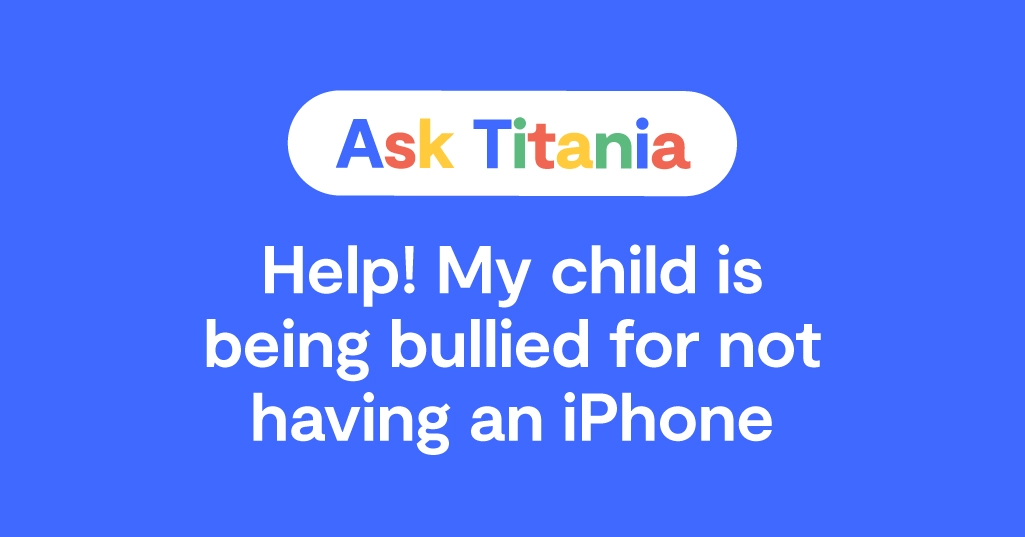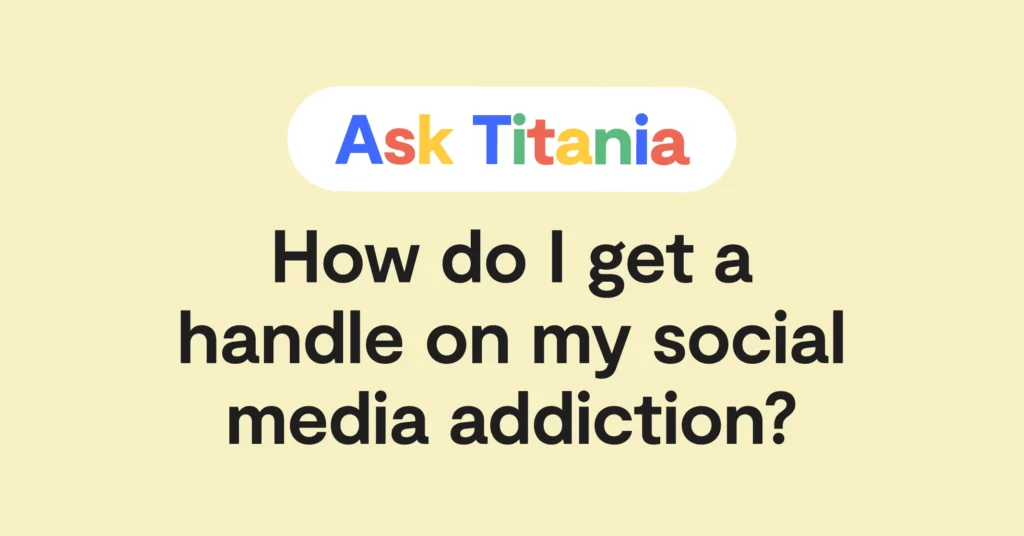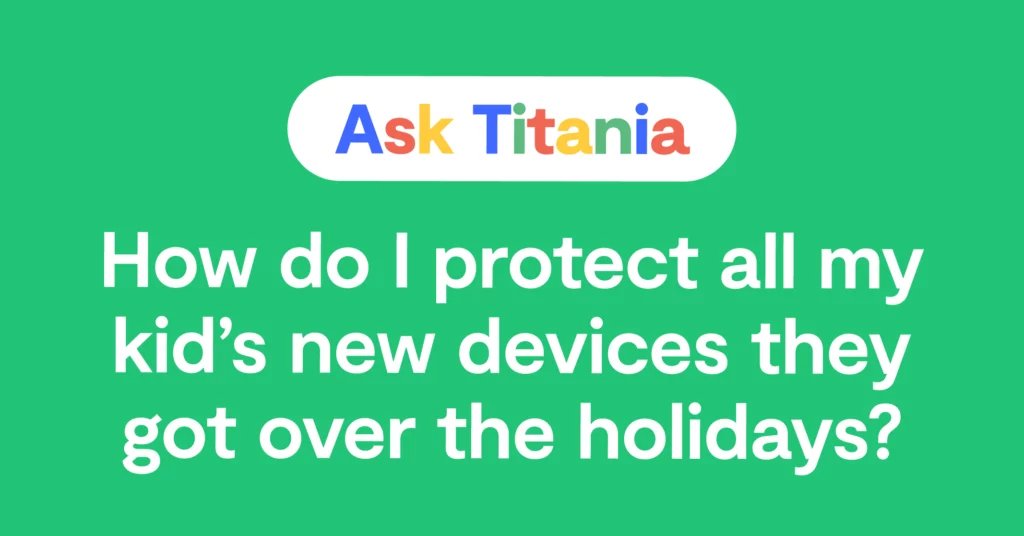
Dear Titania,
I finally got my daughter her first phone, and it’s an Android with Bark. It’s the best choice for our family, as I know Androids work better with parental controls than iPhones. But she says that she’s being teased about having an Android and the dreaded “green bubble” that shows up when she texts friends. Some of them are even saying things like “We’d include you in the group chat if you had an iPhone.” I don’t want to give in to 12-year-old bullies, of course, but how can I make her feel better?
Signed,
Going Bananas Over Bubbles
Dear Going Bananas Over Bubbles
Welcome to the dividing issue of our time! We hear about this constantly, and it’s not just kids and teens who are team iPhone or team Android — some parents even feel pretty strongly about the color of their bubbles!
Androids and iPhones dominate the smartphone market, and in America, iOS devices are preferred ~62% over Android ~38%. Globally, it’s a different story, with Android at ~68% and iPhones at ~32%.
One main difference between the two camps is that Apple only makes iPhones — though there are constantly new versions coming out every few years. On the other hand, Androids are manufactured by a variety of companies, from Samsung to Google and tons more on the lower end of the price spectrum.
Let’s Start With the Facts
First off, Androids are 100% the better option for kids for one main reason: they work better with parental controls and monitoring.
iPhones are known for their stringent privacy rules — and that’s great for adults concerned with big tech — but not so much for parents trying to make sure their children are safe. Children need guardrails when it comes to their first phone.
It’s also true that iPhones and Androids can usually communicate just fine. But when you start getting into group chats, things get a little wonky.
Apple has been behind the times and is the primary cause of these small yet surprisingly annoying frustrations. But starting in 2024, they’re going to address these issues! The good news is that this will make texting work more seamlessly between mixed groups. The bad news is that the green and blue bubble distinction won’t be going anywhere.
Status Symbols Have Always and Will Always Be a Thing
Why are iPhones so popular? In addition to their coveted blue text bubbles, they’re seen as status symbols. New iPhones can cost upwards of a thousand dollars, while low-end Androids can cost a mere $200 or less. I know — that sounds ridiculous. And it is, really, in the grand scheme of things. But technology is a big part of our lives these days, and it’s not going anywhere.
The irony is that a child owning any smartphone is actually pretty incredible, given how much they cost and the power they hold. Kids can just be mean, unfortunately.
But unlike the status symbols of past generations — remember Starter Jackets, American Eagle t-shirts, and countless others — a phone is used daily and is a regular part of life. Jackets don’t always come out if it’s warm, but whether or not you have a blue or green bubble will show up every single day.
Of course, for Gen Z, it’s not just Apple devices. Chick-fil-A, Starbucks, and Amazon also top the list of this generation’s most-coveted brands.
Ways to Address the Bubble Debate
Here are just a few of the ways you can talk to your kid about having an Android.
Listen to their perspective
Growing up is different today, and the smartphone debate is a big digital rite of passage. Talk to your child about what they’ve seen at school and what they’re afraid of.
Acknowledge peer pressure
Depending on your family’s financial situation, iPhones and other expensive brands may not be in the cards. Everyone wants to fit in, but these days it can be harder than ever to keep up with Joneses. Peer pressure is going to be an issue for not just phones, but clothes, cars, and even haircuts. Some parents, of course, do give in and switch to iPhones in an effort to save their child’s feelings. But this is a trade-off that comes with lesser security and more mental health risks.
Highlight common features
At the end of the day, 99% of the most sought-after features for any smartphone are going to be the same — texting, calling, playing games, and taking great photos. Androids are just as capable. And some, like Google Pixels or the newest Samsungs, are just as fancy (if not more so!) than iPhones.
Talk about what real friends do
If a child is being teased for having a green bubble, odds are those kids aren’t close friends. This of course doesn’t make it any easier on a kid that already feels bad, but it’s worth discussing how their real friends will want to text them no matter what color their bubble is.
A Reminder About Time, Youth, and Feelings
For kids, every feeling they have seems like the most important feeling that’s ever been had. This is partly because of hormones, and also because to them, it just may be true. It’s hard to have a lot of perspective when you’re a tween.
Your child will have the entire rest of their life to have an iPhone. Some families even make the transition once a kid has consistently demonstrated responsibility with their technology.
After all, a 16-year-old who’s driving and with a part-time job is different from an 11-year-old just starting out on their digital journey. Younger kids deserve more protection than iPhones can and will allow.
A Brief History of Apple’s Recent Security Flaws
Apple may be a status symbol, but iPhones are just plain riskier — and that’s a fact. Their screen time is notoriously buggy, causing lapses in protection for families and potential exposure to inappropriate content.
Recently, the company came under fire for its new iOS 17 update that makes air-dropping contacts even easier — which means that they’ve made it quicker to exchange contact info.
Kids Can Outsmart Apple Screen Time
Let’s face it — kids know tech better than we do. And one thing they’re really, really good at is circumventing the screen time limits on Apple Screen Time, the free “control” app that Apple provides. It’s not terribly robust, and kids get around the controls you set by installing VPNs or changing the time zone.
With the Bark Phone, kids won’t be able to delete Bark or download workarounds — making it much safer.
What Real Parents Are Saying About Androids
We’ve pulled these comments from parents in our Parenting in a Tech World Facebook group when discussing why Androids are the better choice for families:
- "No matter what I tried, I could not lock down the iPhone to protect my kids. Bark Phones are amazing!"
- "BARK Phone … your time is worth a LOT!!! …peace of mind, and safety … quit fighting the iPhone which is clearly built for loopholes. I’ve had it now for a month and it has completely changed the phone dynamic in my home. My daughter and I can now enjoy technology together and she can earn additional privileges without the many many temptations constantly staring her in the face."
- “Make him a chart that shows all the ways his phone is better than theirs. "If you want subpar tech that's on y'all.” We're an Android family because the phones are consistently better.”
- "Keep the Android. IPhones allow for a lot of ways for kids to get around monitoring.”
- “If it's not an iPhone, it'll be something else. I would use this time to teach him that he shouldn't change for anyone, that he can't give in to peer pressure, and to not worry about what others think. Easier said than done, but these are real-life lessons.”
At the End of the Day, Androids Are the Smarter (and Safer) Choice
Androids allow parental control apps like Bark to work at their best. And if you’re looking for the safest option, the Bark Phone is your absolute best bet.
Not only is our monitoring software built-in to a Samsung A series, the phone also comes with controls built especially for parents — like contact approvals, location tracking, and alerts for sexting and other dangers. iPhones don’t even come close to this level of protection.
Good luck! No matter what, I know you have your child’s best interests at heart. This stuff is hard!
Read more
Bark helps families manage and protect their children’s digital lives.






